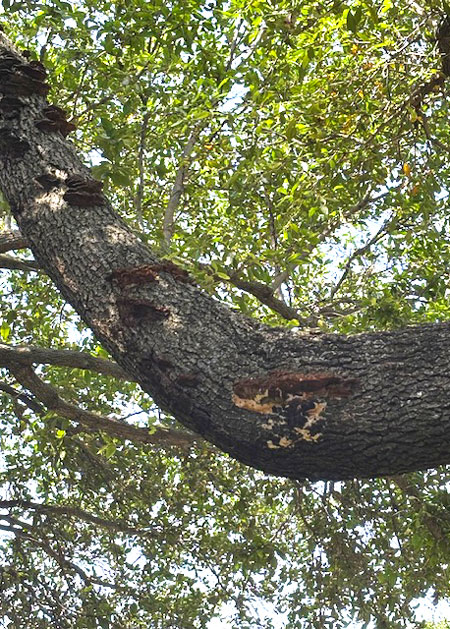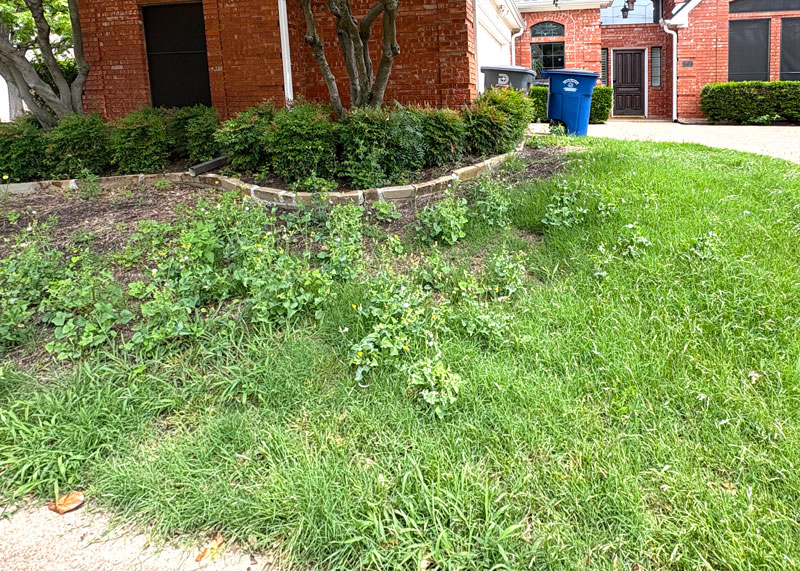Q&A – Ask Neil: May 22, 2025
(Please read these instructions carefully.)
Before you post your question, please look at recent issues to see if someone else has already asked it. You might find your answer there.
How to submit your question…
(Note: You may need to allow a pop-up window to come up in order to get the link for sending your photo(s). If you have already submitted your question and didn’t see the pop-up window, please click here.)
• Click the link provided below to post your question. After you submit your question, a new window will pop up giving you the address to which you can e-mail a SHARP, HIGH-RESOLUTION PHOTO to accompany your question. Please DO NOT SEND THUMBNAIL PHOTOS in case I need to zoom in to see things.
• Click here to post your question.
• Please ONLY POST YOUR QUESTION ONE TIME. We can only accept a set number of questions each week, and when we get duplicates it costs other people their chances.
• One question per reader, please.
• Please use this only for posting questions – not for standard emails.
• Watch for your answer in the following week’s e-gardens.
• I choose those of greatest general interest. For example, plant IDs seldom make the cut.
• I must have your first name or initials.
• I must have your city or county. (Texas is a very large state.)
QUESTION 1
WHAT SHOULD I DO WITH MY LOROPETALUM?
Question: What should I do with my Purple Daydream loropetalum? It’s 18 months old, and it always looks droopy. Its stems don’t stand up. It’s mostly in the sun with a little shade. Should I cut it all the way back or what is the…. Donna C., Rockwall County
Answer: Donna ran out of characters and I didn’t find a photo attached, so I’m going to have to “opinionize” a little bit here. I’ve not seen this cutting short of a question happen before here – sorry about that.
I maintain a mental list for my DFW-area landscape. It’s of the “Never-again, Neil” plants – those plants that have broken my heart one too many times, and loropetalums are on that list. While they do very well in the acidic soils of East Texas in settings that are perfect for azaleas, they are too picky for my tastes in the Metroplex. Rockwall County can be, from my experiences, even more challenging. Soils are certainly quite alkaline (not good for loropetalums). And shade is a requirement, at least from mid-morning on. That, plus the high temperatures and water shortages your county experienced last summer could have made for a tough time for a new one.
Try cutting it back to reshape it. It’s too late in this growing season to relocate it to a shadier spot, but that should be in your plans for next winter. If its leaves shade toward yellowish green and then overall yellow, that’s iron deficiency. That’s what happens in alkaline soils. Don’t kick yourself too hard. Look around and you’ll notice there aren’t a lot of really nice ones growing in Rockwall County. You’re not alone.
QUESTION 2
WHAT IS THIS ON MY VERY LARGE 25-YEAR-OLD LIVE OAK?
Question: What is this on my large 25-year-old live oak? I thought it was mushrooms, but it’s very large and it’s growing. Dianne B., Frisco.
Answer: These are often called “bracket funguses” for obvious reasons. Sometimes they will be associated with mushrooms that crop up out of the soil on the same side of the tree’s trunk. One we commonly see on oaks is in the genus Ganoderma. This whole group of funguses can be fascinating, but they are indications of serious problems within the trees’ tissues. Usually, they are associated with decaying and weakened internal wood. You should have a certified arborist examine your tree carefully to determine the best course of action. There can be severe deterioration of the strength of the wood of the trunk before a homeowner is aware. There is no treatment you can undertake on your own.
QUESTION 3
HOW CAN I ELIMINATE HONEYSUCKLE?
Question: I’ve been battling honeysuckle since I moved in 19 years ago. I thought I had it cleared out, but my neighbors moved in and put a privacy fence in on their side of the fence. It left a gap, and honeysuckle has taken over there. What can I do about it in that space? Honeysuckle has taken over there. Frank R., Benbrook.
Answer: Spray it with a broadleafed weedkiller. I would suggest using a pump sprayer containing only 2,4-D – no other active ingredients combined. You didn’t mention what type of fence you have, but if it’s a chain link fence, you can spray right through it. If it’s a wood fence that just happens to be shorter than your neighbor’s fence, stand atop a short ladder and spray down between the two fences. After 2-4 weeks you may need to spray another time. Coat the leaves of the honeysuckle just to the point of run-off. You are not trying to saturate the soil, just coat the leaves. The herbicide will work while the vine is growing actively (May and June), which is why this is the perfect time.
As for using a product that contains only 2,4-D, most of the most popular products have additional herbicides for controlling other weeds. While 2,4-D is not active in the soil, the other herbicides are and there is risk that they could damage roots of trees and shrubs on the other side of the fence.
QUESTION 4
WHAT IS WRONG WITH MY OKLAHOMA REDBUD?
Question: I planted my Oklahoma redbud beneath a water oak 12 years ago. I assumed it to be an “understory” tree, but maybe this is a little too “understory.” It is losing limbs, and the leaves are decimated with tiny holes. Can it be saved? Bob T., College Station.
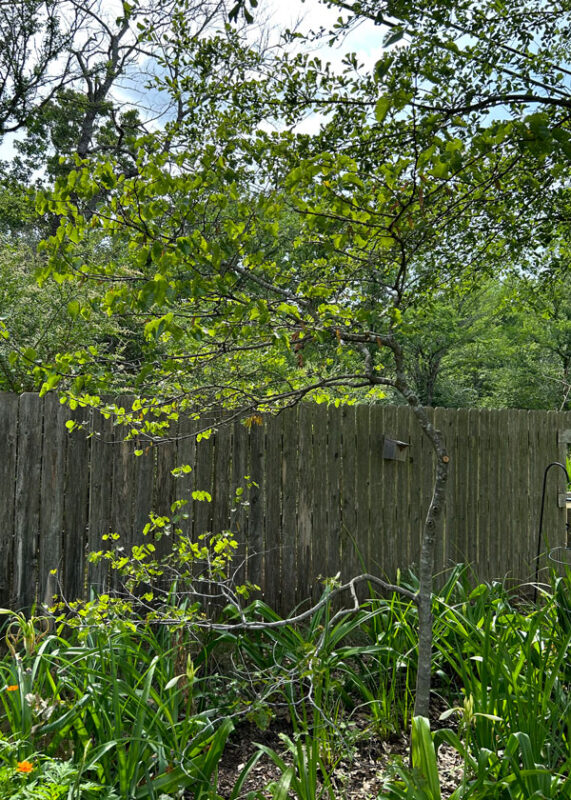
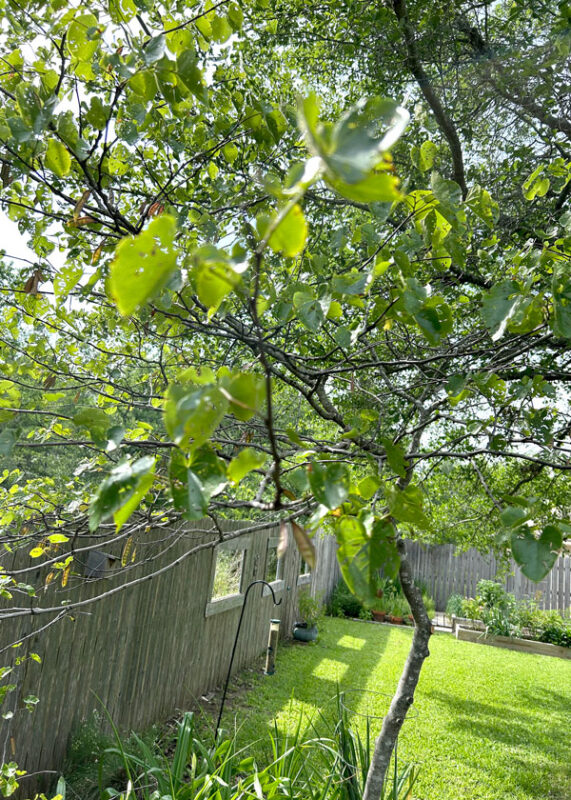
Answer: All redbuds are classed as “understory” trees, but they also do very well when they’re out in full sun as long as they have steady supplies of moisture and reasonably good soils. I love Oklahoma redbuds and still plant them, but I do so knowing that their life expectancy isn’t especially long. Your tree looks like it has struggled along the way. A redbud of that age should have a trunk two or three times larger and its leaves should be much fuller. I don’t think the insect damage to the leaves is responsible in any way, and the lichens along the trunk and branches certainly are not, either. Those branches that have been pruned off look very dried out, as if they were probably dead when they were cut. Add it all up and I fear that your tree won’t be hanging around too many more years. I hope I’m wrong.
QUESTION 5
MY NEIGHBOR’S GOATS ATE ALMOST ALL THE LEAVES FROM MY CRAPE MYRTLES. WILL THEY PUT ON MORE LEAVES THIS SEASON?
Question: My neighbor’s goats escaped their pen and ate my two dwarf crape myrtles while I was out of town. They ate nearly all the lower leaves, then stood on the branches to reach the upper foliage, breaking the branches in the process. Will they put on more leaves this season? Wilda G., Aspermont.
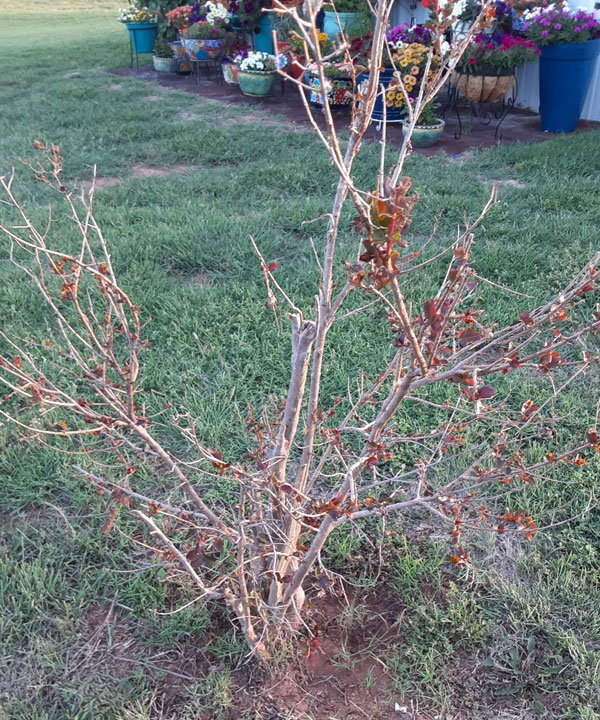
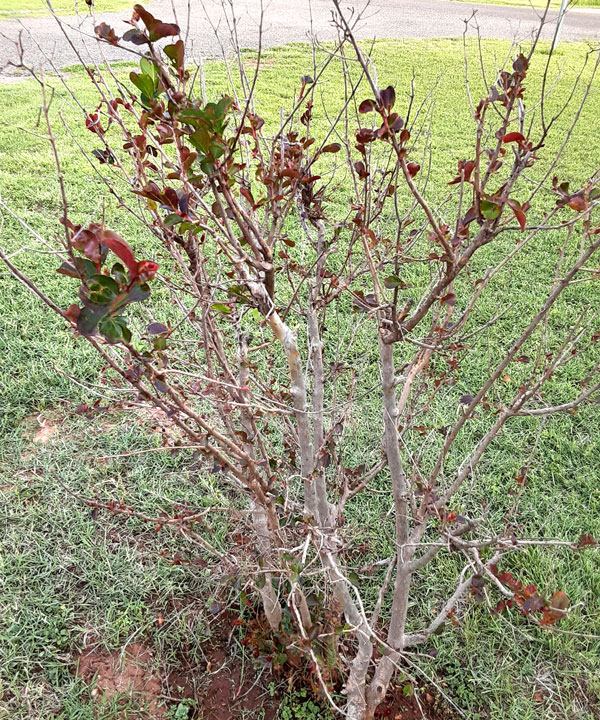
Answer: Absolutely. You can already see it starting to happen. Use very sharp pruning shears to tidy the plants up. Start by removing all broken branches. Then, reshape the plants by removing any healthy branches that extend beyond the desired canopies of the shrubs. This will delay the date of first flowering, but I’ll bet you’ll still get at least one really nice round of flowers, perhaps even two. Fertilize them monthly and water them deeply.
QUESTION 6
WHY WOULD MY TWO CRAPE MYRTLES BE REACTING DIFFERENTLY TO THE SAME CONDITIONS?
Question: I have two crape myrtles about 15 ft. apart with similar sun and water, etc. They are both about 10 years old. One produces healthy vegetative growth each year while the other one looks weak and sparse. What can I do to improve the weak one? Dennis K., Austin.

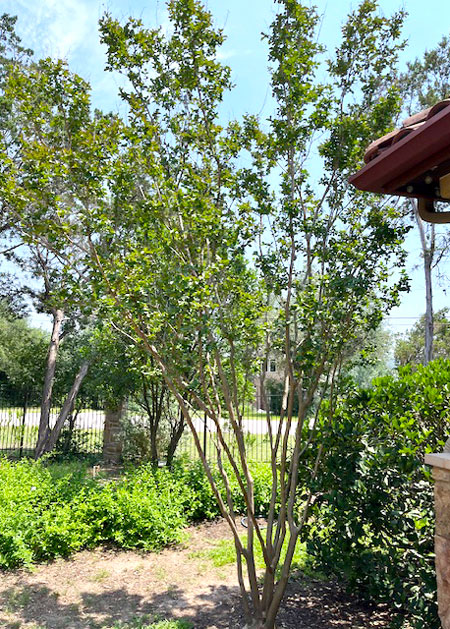
Answer: The one thing you didn’t mention was if they are of the same variety. I work with crape myrtles a couple of days a week as a part of The Crape Myrtle Trails of McKinney here in my hometown, and we see different types react to the same set of environmental conditions just as you are showing. One of the major causes is freeze damage. If we have a very cold first freeze of the fall or record low temperatures over the winter (like February 2021), it can have repercussions for years to follow. There could also be subtle differences in soil depth, irrigation (if you have sprinkler heads and a sprinkler system) and fertilizer. The weaker plant could also have been hurt years ago and may lack the strength to grow vigorously. I’ve seen plants go into long and steady declines over many years.
So, no clear cut answer, but many things for you to consider.
QUESTION 7
Note: We had this question last week and I answered to the best of my ability sans photos to accompany the question. What I didn’t realize was that Olga had sent photos. We had missed them, and I am very sorry that we didn’t see them. So, I’m going to re-post the question and my answer and then give my revised answer beneath it all. You’ll see the “whole package.”
HOW CAN I SAVE MY LAWN?
Question: How can I save my lawn? I’m tired of fighting weeds while the bermuda seems unable to take over the bare spots and weed territory. The whole area is just weeds with some tiny specks of bermuda and St. Augustine. Olga G-O, Dallas, Collin County.
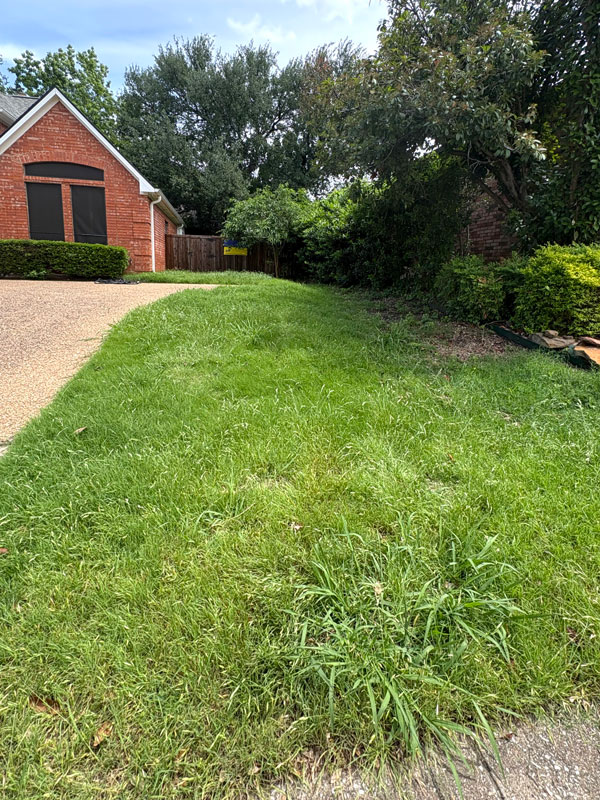
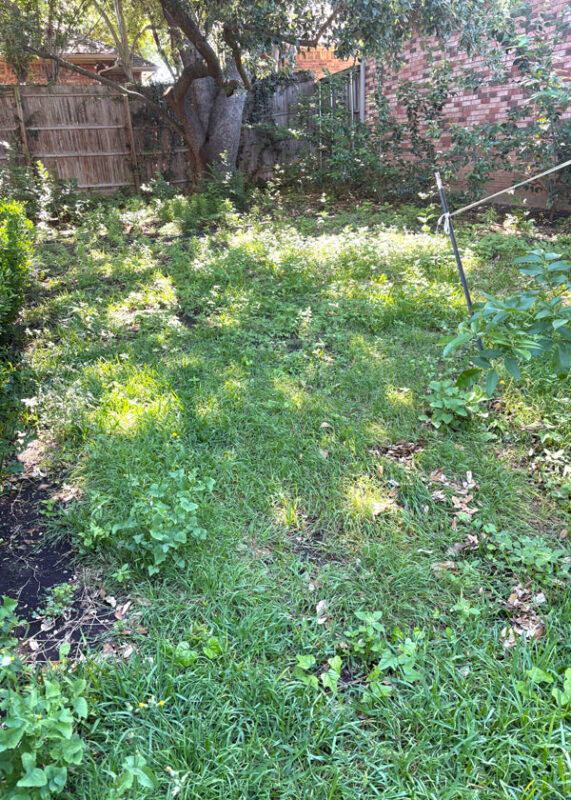
Original answer: Your first step must be to determine why the grass hasn’t been growing up until now. A minimum of 6 hours of direct, hot summer sun daily is required. Lack of sun is the cause of symptoms like you described 95 percent of the time. Poor watering techniques and insect or disease problems would make up the other 5 percent. I know we’ve addressed this from several different angles before here. I do want to help, but without a photo that’s the best I can suggest. It wouldn’t cost that much to buy a few yards of bermuda sod and plant it as a test. If there’s enough sunlight you will be able to tell within 6 or 8 weeks. If the shade is excessive it will obviously begin to thin and die out.
Additional answer: The photos help a lot. Let’s start with regular mowing at 1-1/2 in. That’s the recommended height for bermudagrass turf. That will keep it low and dense, best able to crowd out the weeds. All of your non-grassy (broadleafed) weeds can be controlled by the regular mowing and, in the rare occasions when they persist, applications of a 2,4-D broadleafed weedkiller spray.
The very dark green, heavy clumps of grass that stand out so visibly are dallisgrass. You will either have to dig them out with a sharpshooter spade or spot-treat them with a glyphosate-only herbicide. The weedkiller will kill all grasses, so be very precise to apply it only to the dallisgrass.
As for the shaded area beneath the live oak, start by having the unnecessary lowest branches removed from the tree. There appear to be several that are contributing nothing to the good looks of your landscape. That pruning probably would be better saved until mid-July, although certified arborists know how to protect against the invasion of oak wilt if the trimming must be done sooner than that. There are many weedy tree and vine seedlings up under that tree that can be removed manually or simply by mowing.
I wasn’t asked, but since I was looking at the photos, I see a metal post and a rope pulling on something, I assume a tree trunk. I’m not sure what its purpose is, but remember that you can’t pull a tree back into plumb. As soon as a stake is removed, the tree will fall back out of vertical. You might as well get that stake out of the way unless it is doing something to support a brand new tree. If it is, there are better ways to stake newly planted trees.
Hope that all helps. Again, sorry for our mix-up.

